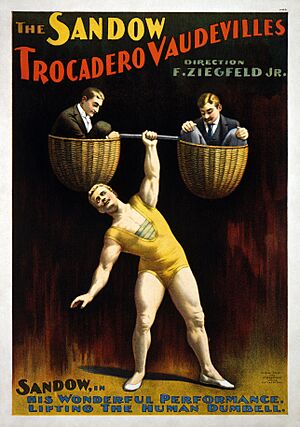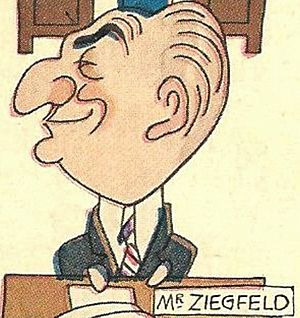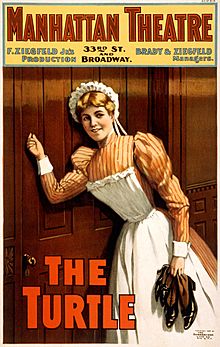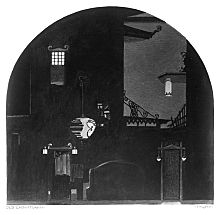Florenz Ziegfeld Jr. facts for kids
Quick facts for kids
Florenz Ziegfeld Jr.
|
|
|---|---|
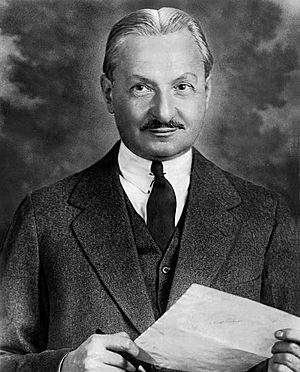
Ziegfeld in 1928
|
|
| Born |
Florenz Edward Ziegfeld Jr.
March 21, 1867 Chicago, Illinois, U.S.
|
| Died | July 22, 1932 (aged 65) Hollywood, California, U.S.
|
| Occupation | Producer, impresario |
| Spouse(s) | |
| Partner(s) | Anna Held (1897–1913) |
| Children | Patricia Ziegfeld Stephenson |
Florenz Edward Ziegfeld Jr. (born March 21, 1867 – died July 22, 1932) was a famous American Broadway producer. He was known for creating spectacular stage shows called revues. His most famous shows were the Ziegfeld Follies, which ran from 1907 to 1931. These shows were inspired by the Folies Bergère in Paris.
Ziegfeld also produced the very popular musical Show Boat. People often called him the "glorifier of the American girl" because of how he presented the beautiful performers in his shows. He is a member of the American Theater Hall of Fame.
Contents
Florenz Ziegfeld's Early Life
Florenz Edward Ziegfeld Jr. was born on March 21, 1867, in Chicago, Illinois. His mother, Rosalie, was from Belgium. His father, Florenz Edward Ziegfeld, was a German immigrant.
When Florenz was a child, he saw the terrible Chicago fire of 1871. His father ran the Chicago Musical College. Later, his father opened a nightclub called the Trocadero. This was to attract visitors to the 1893 World's Fair in Chicago. To help his father's club, Ziegfeld hired and managed a famous strongman named Eugen Sandow.
Starting His Career
During a trip to Europe, Ziegfeld met a young Polish-French singer named Anna Held. He helped her become very famous in America. Anna Held was the one who first suggested that Ziegfeld create an American version of the Parisian Folies Bergère.
Her success in his Broadway shows, especially A Parisian Model in 1906, led him to start his own grand stage shows in 1907. Ziegfeld was very good at creating publicity stunts and rumors to get the American press to talk about his shows and performers.
The Ziegfeld Follies
Ziegfeld's amazing stage shows were called the Ziegfeld Follies. The first one opened on July 7, 1907. He produced these shows every year until 1931. The Follies were huge, with fancy costumes and detailed sets. Ziegfeld personally chose the beautiful performers.
The shows featured music by famous composers like Irving Berlin, George Gershwin, and Jerome Kern. The most famous performers were the Ziegfeld girls. These were female chorus dancers who wore elaborate costumes and performed together perfectly.
Many performers became even more famous and successful after working with Ziegfeld. Some of these stars included Nora Bayes, Fanny Brice, Ruth Etting, W. C. Fields, Eddie Cantor, Marilyn Miller, Will Rogers, Bert Williams, and Ann Pennington.
Family Life
Ziegfeld and Anna Held lived together starting in 1897. They separated in 1913.
On April 11, 1914, Ziegfeld married actress Billie Burke. They met at a New Year's Eve party. They had one child, a daughter named Patricia Ziegfeld Stephenson (1916–2008). The family lived on his estate in Hastings-on-Hudson, New York, and also in Palm Beach, Florida.
The Ziegfeld Theatre and Show Boat
Ziegfeld spent about $2.5 million to build the 1600-seat Ziegfeld Theatre in New York City. It was designed by Joseph Urban and Thomas W. Lamb. The theater had an egg-shaped auditorium and a huge mural called The Joy of Life on its walls and ceiling.
The Ziegfeld Theatre opened in February 1927 with Ziegfeld's show Rio Rita. This show ran for almost 500 performances. After that came Show Boat, which was a massive hit and ran for 572 performances.
Show Boat was a musical about racial discrimination in the South during the late 1800s. Ziegfeld worked with Joseph Urban and composer Jerome Kern on this show. Show Boat has been brought back to Broadway many times and has won several Tony Awards. It includes classic songs like "Ol' Man River" and "Can't Help Lovin' Dat Man".
Later Years and Legacy
Ziegfeld lost a lot of his money during the stock market crash in 1929. In May 1932, he brought Show Boat back to the stage. It ran for six months, which was a success during the tough times of the Great Depression. That same year, he brought his Follies stars to CBS Radio for a show called The Ziegfeld Follies of the Air.
Florenz Ziegfeld died in Hollywood, California, on July 22, 1932. He passed away from a lung infection. His death left his wife, Billie Burke, with many debts. She had to act in films to pay them off. Florenz Ziegfeld and Billie Burke are buried in Kensico Cemetery in Valhalla, New York.
Accolades
Ziegfeld was chosen to be a member of the American Theatre Hall of Fame.
Broadway Productions Images
Films Based on Ziegfeld's Work
Several films were made based on Ziegfeld's stage musicals.
- The 1929 film Show Boat included a special introduction by Ziegfeld himself. It also featured parts of the stage show performed by the original Broadway cast. Later film versions of Show Boat were made in 1936 and 1951.
- RKO Pictures had a big hit with its movie version of Rio Rita (1929), starring Bebe Daniels and John Boles.
- Marilyn Miller played her famous stage role again in the film Sally (1929).
- Eddie Cantor also played his popular Broadway role in the film Whoopee! (1930). Ziegfeld himself produced this film with Samuel Goldwyn.
Archive
The Academy Film Archive keeps a collection of items related to Florenz Ziegfeld and Billie Burke. This collection mainly includes home movies.
See also
 In Spanish: Florenz Ziegfeld para niños
In Spanish: Florenz Ziegfeld para niños


